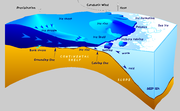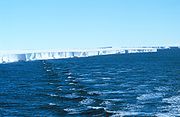
Ice shelf
Encyclopedia


Glacier
A glacier is a large persistent body of ice that forms where the accumulation of snow exceeds its ablation over many years, often centuries. At least 0.1 km² in area and 50 m thick, but often much larger, a glacier slowly deforms and flows due to stresses induced by its weight...
or ice sheet
Ice sheet
An ice sheet is a mass of glacier ice that covers surrounding terrain and is greater than 50,000 km² , thus also known as continental glacier...
flows down to a coast
Coast
A coastline or seashore is the area where land meets the sea or ocean. A precise line that can be called a coastline cannot be determined due to the dynamic nature of tides. The term "coastal zone" can be used instead, which is a spatial zone where interaction of the sea and land processes occurs...
line and onto the ocean surface. Ice shelves are only found in Antarctica, Greenland
Greenland
Greenland is an autonomous country within the Kingdom of Denmark, located between the Arctic and Atlantic Oceans, east of the Canadian Arctic Archipelago. Though physiographically a part of the continent of North America, Greenland has been politically and culturally associated with Europe for...
and Canada
Canada
Canada is a North American country consisting of ten provinces and three territories. Located in the northern part of the continent, it extends from the Atlantic Ocean in the east to the Pacific Ocean in the west, and northward into the Arctic Ocean...
. The boundary between the floating ice shelf and the grounded (resting on bedrock) ice that feeds it is called the grounding line. The thickness of ice shelves ranges from about 100 to 1000 metres.
In contrast, sea ice
Sea ice
Sea ice is largely formed from seawater that freezes. Because the oceans consist of saltwater, this occurs below the freezing point of pure water, at about -1.8 °C ....
is formed on water, is much thinner (typically less than 3m), and forms throughout the Arctic Ocean
Arctic Ocean
The Arctic Ocean, located in the Northern Hemisphere and mostly in the Arctic north polar region, is the smallest and shallowest of the world's five major oceanic divisions...
. It also is found in the Southern Ocean
Southern Ocean
The Southern Ocean comprises the southernmost waters of the World Ocean, generally taken to be south of 60°S latitude and encircling Antarctica. It is usually regarded as the fourth-largest of the five principal oceanic divisions...
around the continent of Antarctica.
Ice shelves are principally driven by gravity-driven pressure from the grounded ice That flow continually moves ice from the grounding line to the seaward front of the shelf. The primary mechanism of mass loss from ice shelves is iceberg
Iceberg
An iceberg is a large piece of ice from freshwater that has broken off from a snow-formed glacier or ice shelf and is floating in open water. It may subsequently become frozen into pack ice...
calving
Ice calving
Ice calving, also known as glacier calving or iceberg calving, is a form of ice ablation or ice disruption. It is the sudden release and breaking away of a mass of ice from a glacier, iceberg, ice front, ice shelf, or crevasse...
, in which a chunk of ice breaks off from the seaward front of the shelf. Typically, a shelf front will extend forward for years or decades between major calving events. Snow accumulation on the upper surface and melting from the lower surface are also important to the mass balance of an ice shelf. Ice may also accrete onto the underside of the shelf.
The density contrast between glacial ice, which is denser than normal ice, and liquid water means that only about 1/9 of the floating ice is above the ocean surface. The world's largest ice shelves are the Ross Ice Shelf
Ross Ice Shelf
The Ross Ice Shelf is the largest ice shelf of Antarctica . It is several hundred metres thick. The nearly vertical ice front to the open sea is more than 600 km long, and between 15 and 50 metres high above the water surface...
and the Filchner-Ronne Ice Shelf
Filchner-Ronne Ice Shelf
The Filchner-Ronne Ice Shelf, also known as Ronne-Filchner Ice Shelf, is an Antarctic ice shelf bordering the Weddell Sea.-Description:...
in Antarctica.
The term captured ice shelf has been used for the ice over a subglacial lake
Subglacial lake
A subglacial lake is a lake under a glacier, typically an ice cap or ice sheet. There are many such lakes, with Lake Vostok in Antarctica being by far the largest known at present.-Characteristics:...
, such as Lake Vostok
Lake Vostok
Lake Vostok is the largest of more than 140 subglacial lakes found under the surface of Antarctica. The overlying ice provides a continuous paleoclimatic record of 400,000 years, although the lake water itself may have been isolated for 15 to 25 million years. The lake is named after the...
.
Canadian ice shelves
All Canadian ice shelves are attached to Ellesmere IslandEllesmere Island
Ellesmere Island is part of the Qikiqtaaluk Region of the Canadian territory of Nunavut. Lying within the Canadian Arctic Archipelago, it is considered part of the Queen Elizabeth Islands, with Cape Columbia being the most northerly point of land in Canada...
and lie north of 82°N. Ice shelves that are still in existence are the Alfred Ernest Ice Shelf
Alfred Ernest Ice Shelf
The Alfred Ernest Ice Shelf is an ice shelf on the north-west part of Ellesmere Island, Canada. This ice mass is one of four remaining ice shelves on the island.This ice shelf lies between Alert Point and Cape Woods on Wootton Peninsula...
, Milne Ice Shelf
Milne Ice Shelf
The Milne Ice Shelf, a fragment of the former Ellesmere Ice Shelf, is located in Qikiqtaaluk Region, Nunavut, Canada. It is the second largest ice shelf in the Arctic Ocean...
, Ward Hunt Ice Shelf
Ward Hunt Ice Shelf
The Ward Hunt Ice Shelf is the largest ice shelf in the Arctic, located on the north coast of Ellesmere Island, Nunavut, Canada. During the 20th century the Ellesmere Ice Shelf broke up into six separate shelves, the largest being Ward Hunt...
and Smith Ice Shelf. The Ayles Ice Shelf
Ayles Ice Shelf
The Ayles Ice Shelf was one of six major ice shelves in Canada, all located on the northern coast of Ellesmere Island, Nunavut. The ice shelf broke off from the coast on August 13, 2005, forming a giant ice island thick and measuring around by in size . The oldest ice in the ice shelf is...
broke up in 2005, M'Clintock Ice Shelf
M'Clintock Ice Shelf
The M'Clintock Ice Shelf was a Canadian ice shelf attached to northern Ellesmere Island. By 1961/62, its connection was tenuous. Most of the shelf broke away during the period of 1963 through 1965 with the remainder breaking off in 1966. Subsequently, multi year landfast sea ice, containing ice...
broke up from 1963 to 1966 and Markham Ice Shelf
Markham Ice Shelf
The Markham Ice Shelf was one of five major ice shelves in Canada, all located on the northern coast of Ellesmere Island, Nunavut. The ice shelf broke off from the coast in early August 2008, becoming adrift in the Arctic Ocean. At the time, the 4,500 year old ice shelf was in size, nearly the...
broke up in 2008.
Antarctic ice shelves
See also: List of Antarctic ice shelvesA total of 44 percent of the Antarctic coastline has ice shelves attached. Their aggregate area is 1,541,700 km² http://www.stat.fi/tup/maanum/01_maantieteellisia_tietoja_aihepiireittain.xls.
Ice shelf disruption

The Ellesmere ice shelf reduced by 90 percent in the twentieth century, leaving the separate Alfred Ernest, Ayles, Milne, Ward Hunt, and Markham Ice Shelves. A 1986 survey of Canadian ice shelves found that 48 km². (3.3 cubic kilometers) of ice calved from the Milne and Ayles ice shelves between 1959 and 1974. The Ayles Ice Shelf calved entirely on August 13, 2005. The Ward Hunt Ice Shelf, the largest remaining section of thick (>10 m) landfast sea ice along the northern coastline of Ellesmere Island, lost 600 square km of ice in a massive calving in 1961-1962. It further decreased by 27% in thickness (13 m) between 1967 and 1999. In summer 2002, the Ward Ice Shelf experienced another major breakup.
Two sections of Antarctica's Larsen Ice Shelf
Larsen Ice Shelf
The Larsen Ice Shelf is a long, fringing ice shelf in the northwest part of the Weddell Sea, extending along the east coast of Antarctic Peninsula from Cape Longing to the area just southward of Hearst Island...
broke apart into hundreds of unusually small fragments (hundreds of meters wide or less) in 1995 and 2002.
The breakup events may be linked to the dramatic polar warming trends that are part of global warming
Global warming
Global warming refers to the rising average temperature of Earth's atmosphere and oceans and its projected continuation. In the last 100 years, Earth's average surface temperature increased by about with about two thirds of the increase occurring over just the last three decades...
. The leading ideas involve enhanced ice fracturing due to surface meltwater
Meltwater
Meltwater is the water released by the melting of snow or ice, including glacial ice and ice shelfs over oceans. Meltwater is often found in the ablation zone of glaciers, where the rate of snow cover is reducing...
and enhanced bottom melting due to warmer ocean water circulating under the floating ice.
The cold, fresh water produced by melting underneath the Ross and Flichner-Ronne ice shelves is a component of Antarctic Bottom Water
Antarctic Bottom Water
The 'Antarctic Bottom Water' is a type of water mass in the seas surrounding Antarctica with temperatures ranging from 0 to -0.8◦ C, salinities from 34.6 to 34.7 psu, and a density near 27.88...
.
Although it is believed that the melting of floating ice shelves will not raise sea levels, technically, there is a small effect because sea water is ~2.6% more dense than fresh water combined with the fact that ice shelves are overwhelmingly "fresh" (having virtually no salinity); this causes the volume of the sea water needed to displace a floating ice shelf to be slightly less than the volume of the fresh water contained in the floating ice. Therefore, when a mass of floating ice melts, sea levels will increase; however, this effect is small enough that if all extant sea ice and floating ice shelves were to melt, the corresponding sea level rise is estimated to be ~4 cm.
External links
- http://www.antdiv.gov.au/default.asp?casid=1547 - from the Australian Antarctic Division
- http://nsidc.org/quickfacts/iceshelves.html - from the U.S. National Snow and Ice Data Center
- http://www.cnn.com/2006/TECH/science/12/29/canada.arctic.ap/index.html - CNN story about the Canadian Ayles ice shelf break up in August 2005
- http://ice-glaces.ec.gc.ca/ - from the Canadian Ice Service

